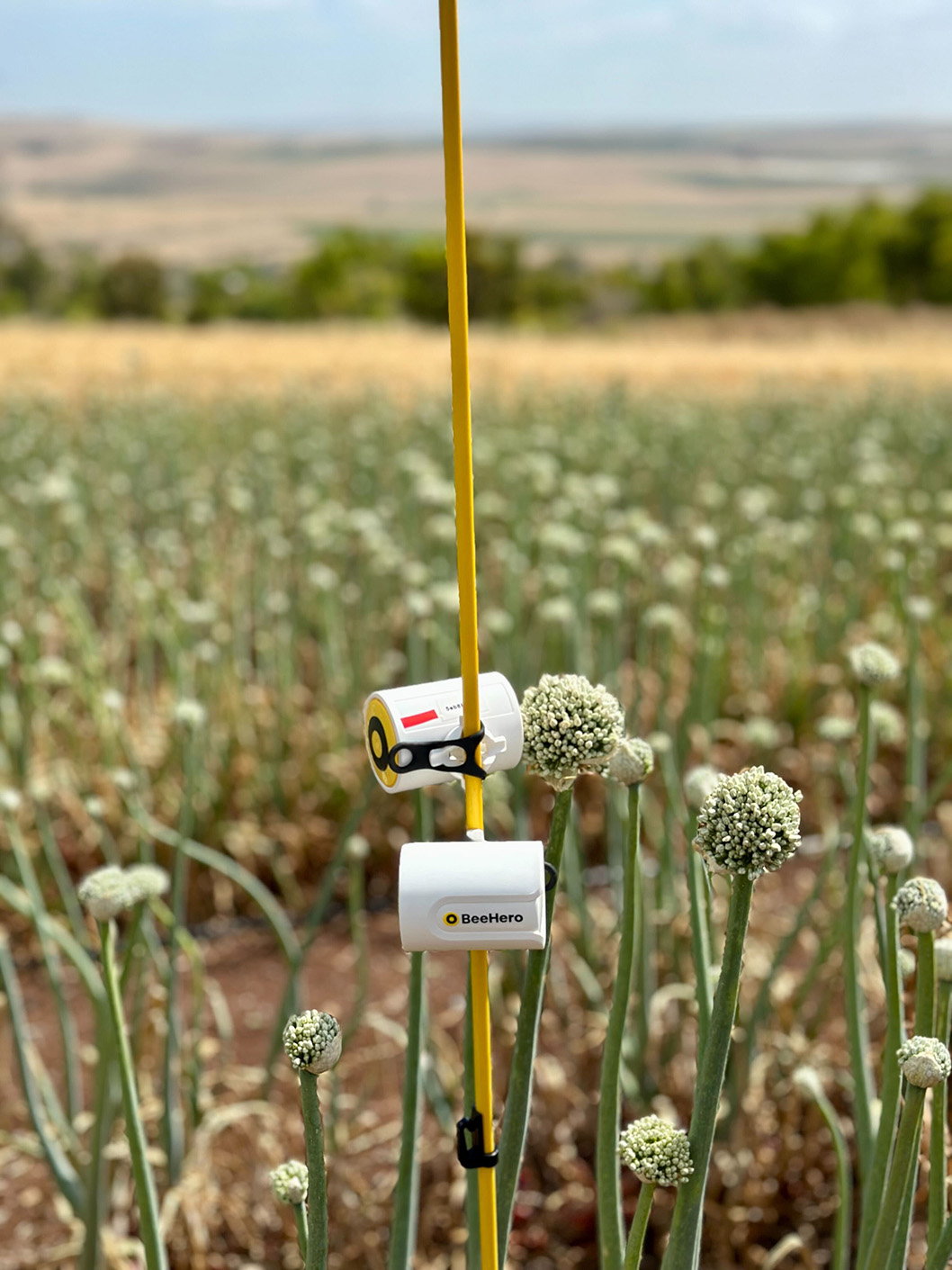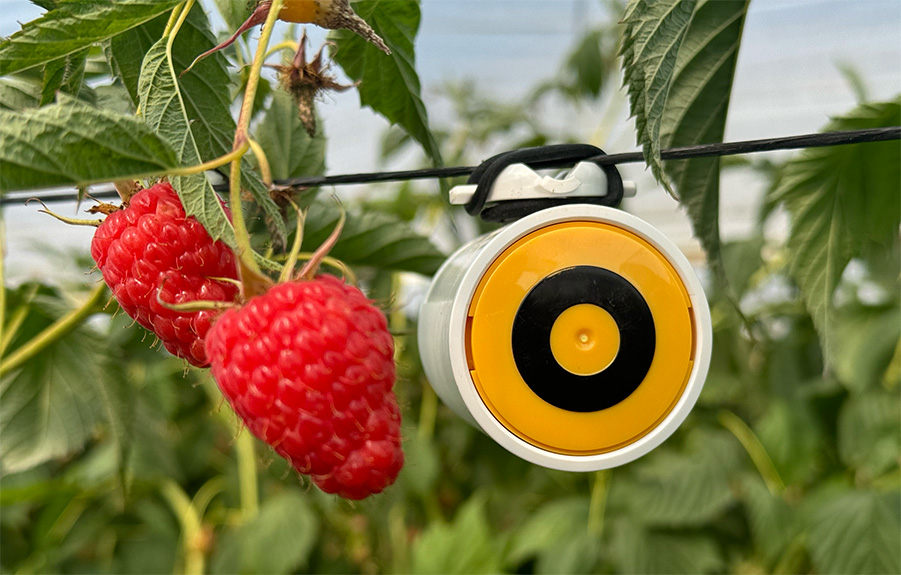Australian Rural & Regional News asked some further questions of Yuval Regev, Co-founder and CTO of BeeHero, answered below the release.
The updated sensing solution, already in use worldwide, enables first-of-its-kind, high resolution heat mapping of bee activity, and features improved sensing and pollinator monitoring capabilities that enable predictive models for pollination success.
BeeHero, Media Release, 31 July 2024
B eeHero, the pioneer of data-driven precision pollination, announced today the launch of the upgraded version of its Pollination Insight Platform (PIP) in-field sensing solution, which measures pollinator activity in crops to improve pollination efficacy and increase yields. Building on the success of the initial offering, PIP 2.0 features expanded pollinator identification, enhanced sensor design, advanced monitoring capabilities, innovative heat map technology, and comprehensive field coverage to provide precise, real-time data-driven insights and predictive models for growers.
Approximately 75 per cent of major food crops depend on pollinators, with bees the most vital among them. Consequently, effective and efficient pollination is a cornerstone of sustainable agriculture, biodiversity, and future global food security. Leveraging its proprietary sensing technology, BeeHero monitors the frequencies of bees in the field to determine the rate of pollinator visits, thereby allowing growers to assess the effectiveness of pollination, identify potential issues, and take proactive measures to improve results.
The PIP 2.0 in-field sensing solution now offers first-of-its-kind, high resolution heat map technology, which monitors bee activity in the field in real time, providing growers with unprecedented and invaluable insights into pollination progress. The solution offers comprehensive coverage and precise data, replacing traditional, manual methods of in-field data collection. This innovative approach allows growers to identify preferred foraging times and varieties; to access real-time bee activity; to assess the relationship between hive numbers and quality, spacing, and orchard activity; to monitor the ratio of bee visits to male and female rows of crop flowers per minute; and to build predictive models for yield and pollination success, particularly for seed production and cross-pollinated crops like almonds, blueberries, and more.
Additionally, PIP 2.0 can identify a wide range of pollinators, including leaf-cutter bees, hover flies, carpenter bees, bumblebees, and honeybees. This expanded identification capability allows for a more comprehensive understanding of pollinator activity and contributions in the field, leading to more informed decisions for crop management. The upgraded and newly designed sensor is also significantly more resilient and robust, with the ability to turn towards the bloom, to be adjusted to various heights, and to provide better coverage of the field due to its round shape. Additionally, the device is now waterproof and boasts enhanced sound capabilities and noise cancellation, ensuring reliable performance in diverse environmental conditions.
“PIP 2.0 represents a transformative step forward in agriculture technology. It not only provides growers with unparalleled insights and control over their pollination processes, but also catapults BeeHero’s database of bee activity – the largest such database in the world, already fueled by the 25M in-hive samples collected daily by BeeHero – to new heights,” said Omer Davidi, CEO and Co-Founder of BeeHero. “BeeHero is consistently pushing the boundaries of innovation to support both growers and beekeepers. By continuously advancing our sensor technology and real-time data analytics, we are empowering them to optimize yields, reduce labor costs, and enhance the sustainability and profitability of their operations unlike ever before.”
The PIP 2.0 platform is now operational across the U.S., Israel, France, Holland, Australia, and South Africa, and has expanded its application to monitor and optimize the pollination of diverse seed crops such as onion, carrot, sunflower, watermelon, and radish, and fruit crops such as apples, blueberries and raspberries.
About BeeHero
BeeHero is a data-driven technology company redefining pollination in commercial agriculture. Using advanced data analytics, artificial intelligence, and low-cost IoT sensors, BeeHero brings transparency and efficiency to the complex logistics of commercial crop pollination. Its Precision Pollination as a Service (PPaaS) results in better crop yields and increased profits for commercial crop growers and agribusiness stakeholders. Its precision pollination solution is rapidly evolving into the backbone of the data-driven approach needed to build a resilient and future-proof sustainable agriculture ecosystem. The company is headquartered in Fresno, California, with offices in Palo Alto, California and R&D in Tel Aviv, Israel.
Australian Rural & Regional News asked some questions of Yuval Regev, Co-founder and CTO of BeeHero
ARR.News: Having real time data on bee activity seems to be a key difference with this update, is that so? Can you explain the practical difference that makes for growers? For instance, how that might affect their day’s work, and also the potential yield down the track.
Yuval Regev: There are numerous updates to the PIP solution that are benefitting growers. The improved in-field sensing solution now offers more comprehensive field coverage and the ability to identify and monitor a wider range of activity and pollinators. Based on these enhanced capabilities, the solution now enables innovative heat mapping that demonstrates bee activity in a grower’s field in real time, allowing them to make more informed decisions and intervene when necessary to better support their pollination efforts. The solution now also supports predictive models for growers, which helps them plan and adjust their efforts for both ongoing and future seasons.
ARR.News: What are the telecommunications requirements of the tool? (Noting the switch to 5G networks, the shutdown of 3G and black spots in Australia)
Yuval Regev: BeeHero’s technology relies on 4G networks, specifically utilising LTE and NB-IoT technologies. Given the general reception challenges in agricultural areas, NB-IoT, which is designed for IoT products like ours, allows us to maintain good performance even in areas with very poor cellular reception.
In light of the transition to 5G networks and the shutdown of 3G, our use of 4G LTE and NB-IoT ensures compatibility and reliable operation. To further enhance reception, we’ve upgraded the cellular antenna of our modem and, in some cases, elevated the modem’s position. These improvements, along with our ability to operate on the NB-IoT network, enable us to function effectively even in remote and challenging locations.
ARR.News: How has the uptake of the original tool been in Australia so far?
Yuval Regev: This is our first introduction to the Australian market with this product and we are extremely excited to see how it will be received.
ARR.News: Any particular areas or industries more receptive than others?
Yuval Regev: The platform is currently in use globally in countries including the U.S., Israel, France, Holland, Australia, and South Africa.
PIP is applicable to a diverse range of fruit crops, including apples, blueberries, and raspberries, as well as crops that require cross-pollination. Seed crop producers can also particularly benefit from PIP 2.0’s predictive modeling, which can improve seed quality and production efficiency for crops like onion, carrot, and sunflower.
ARR.News: Are there particular areas or industries that will benefit more from the updated tool?
Yuval Regev: Several sectors will benefit from the updated Pollination Insight Platform 2.0 (PIP 2.0). In commercial agriculture, growers of pollinator-dependent crops like fruits and seed crops will see improved pollination and increased crop yields. For seed production, PIP 2.0’s predictive models enhance pollination success and yield quality. Biodiversity conservation efforts will also benefit, as the platform provides insights into pollinator activity, supporting sustainable agriculture and ecological balance. Additionally, agribusiness stakeholders will gain from data-driven insights that lead to better decision-making and increased profitability. In addition, we can point to the number of visits to different varieties, and also the ratio between the visits to male and female flowers, and that gives us a clear probability of the pollination outcomes.
ARR.News: Is the information collected by the tool the intellectual property of the grower?
Yuval Regev: The data collected by PIP 2.0 is sent to the cloud, where it is analyzed using BeeHero’s proprietary AI algorithms. The resulting insights are made available to the growers via a dashboard and app. Additionally, this data contributes to BeeHero’s database of bee activity—the largest of its kind in the world—further enhancing the insights provided to growers and beekeepers across the board.
ARR.News: What arrangements does BeeHero make with the growers regarding the use of data collected?
Yuval Regev: BeeHero ensures that all the relevant data collected from the fields is fully accessible to the growers. They receive detailed insights and analytics regarding their crops, which empower them to make informed decisions and optimise their pollination operations. BeeHero’s commitment is to provide transparent and actionable data, fostering a collaborative relationship that enhances the efficiency and productivity of their agricultural practices.
ARR.News: Would the tool be most effective and the data collected most useful if in use by growers across a broad area?
Yuval Regev: Pollination data from a broader area and more diverse crops and regions enriches BeeHero’s ability to provide insights to growers because it captures diverse environmental conditions, provides a fuller picture of pollinator behavior, improves accuracy by reducing location-specific anomalies, and reflects ecosystem connectivity. It also helps in identifying regional trends.
ARR.News: Does the data collected so far suggest any significant world wide, or nationwide trends that Bee Hero can speak to?
Yuval Regev: Yes, we can identify patterns that influence bee flight hours based on temperature, location, humidity, wind speed, bloom status and additional factors. This is crucial as each region, crop and variety have different characteristics, and using our accumulated knowledge we can give growers exact recommendations on their pollination needs.
Related story: BeeHero: Revolutionising bee innovation


